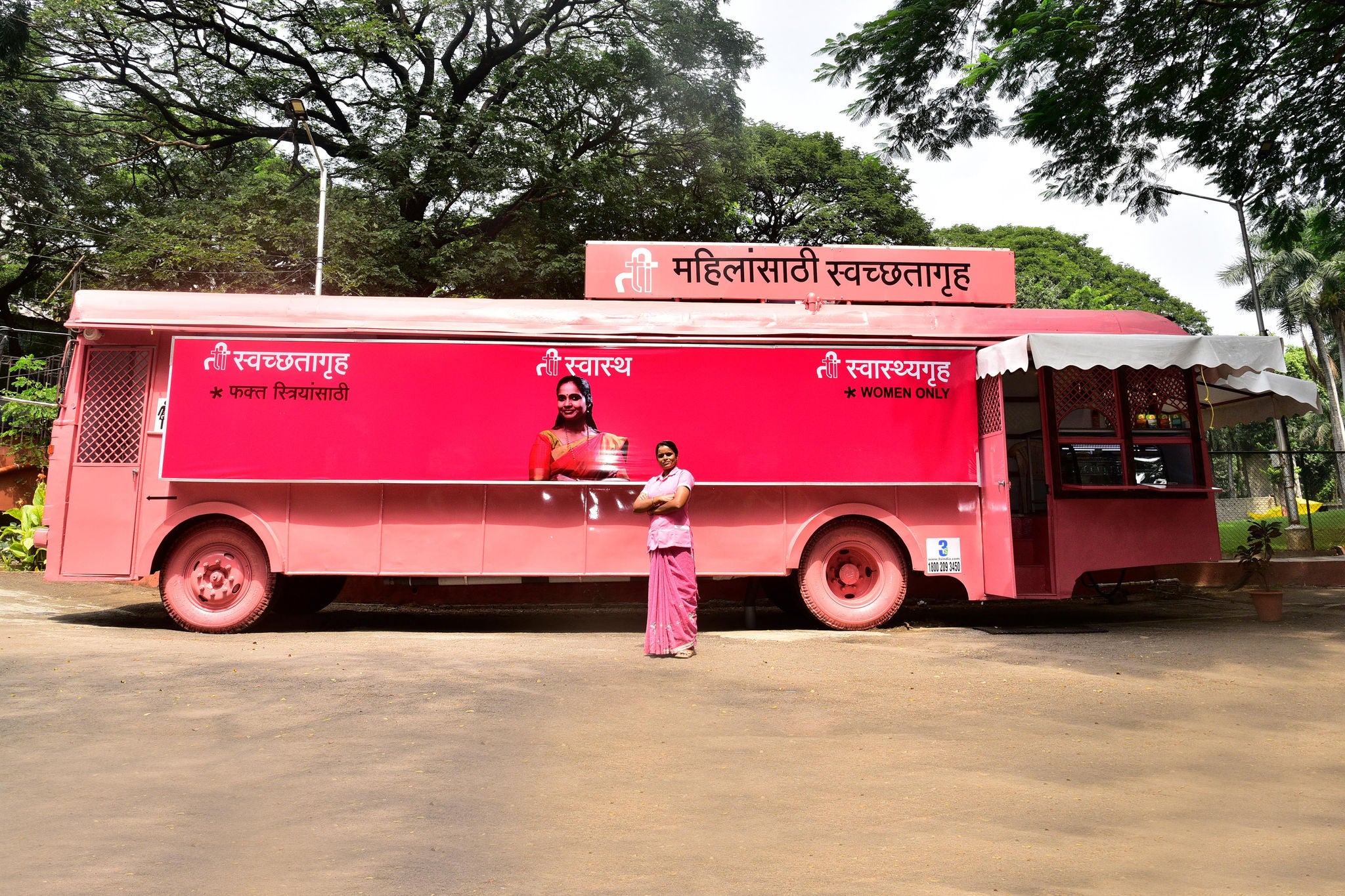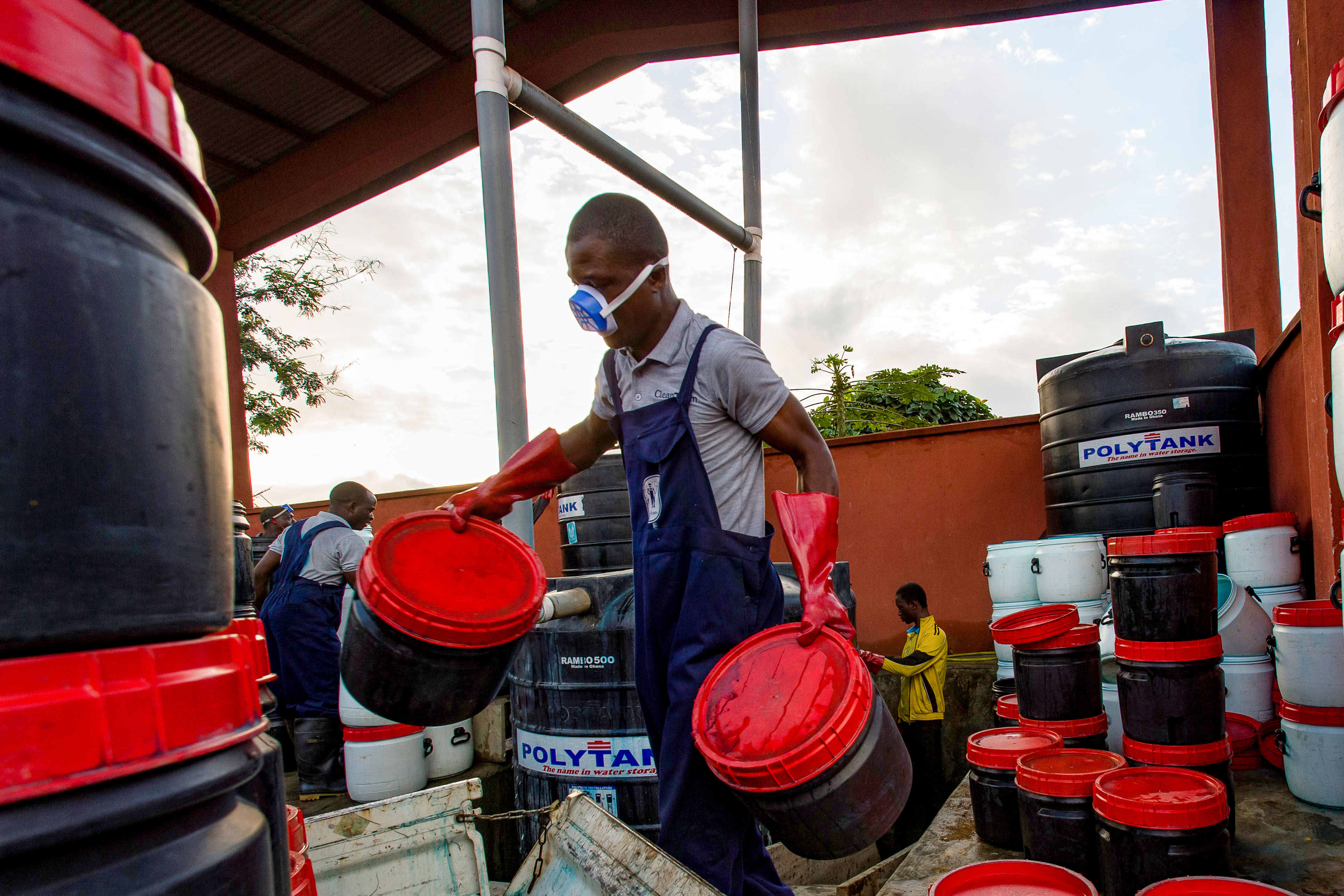EY refers to the global organization, and may refer to one or more, of the member firms of Ernst & Young Global Limited, each of which is a separate legal entity. Ernst & Young Global Limited, a UK company limited by guarantee, does not provide services to clients.

Lessons from leading sanitation entrepreneurs can help scale better answers to the global sanitation crisis.
Around the world today, a staggering 4.2 billion people still lack access to safely managed sanitation, and the UN has estimated that reaching the Sustainable Development Goal (SDG) of equitable sanitation for all by 2030 requires doubling the current rate of change.
With nearly 830,000 people a year in low- and middle-income countries dying as a result of poor water, sanitation and hygiene — and associated health care costs and lost economic productivity estimated to have cost the global economy close to US$225 billion in 2015 — the case for change couldn’t be clearer.
But there’s also another reason.
Compounding these costs is a massive lost opportunity. Trillions of liters of “toilet resources” — the Toilet Board Coalition’s (TBC) preferred term for human waste — currently go lost and untreated every year. Their capture, treatment and productive use could create a transformative sanitation economy estimated to be worth US$62 billion a year in India alone by 2021.
United in the belief that entrepreneurial enterprise is critical to accelerating progress toward this vision, a joint study by EY and the TBC (pdf) aims to shift the focus of debate. Drawing on lessons from past and present participants of the TBC’s Sanitation Economy Accelerator program, it not only highlights how better answers to the global sanitation crisis already exist, it also illustrates eight practical steps that can be taken to help these life-changing businesses scale more rapidly and sustainably.
1. Make sanitation part of a broader user experience
Developed to provide a safe, clean and familiar sanitation experience for low-income urban women in Pune, India, 3S (a division of Sara Plast Pvt Ltd.) is repurposing old city buses as sanitation kiosks, complete with toilets, shower cubicles, diaper changing stations and sanitary pad vending machines.
Similarly targeting specific demographics — this time blue-collar workers, commuters and tourists in Indore, the most populous city in the state of Madhya Pradesh, India — Lootel is pioneering another innovative value proposition. It uses a “pay, use, redeem” model, whereby customers of its Lootel Cafés can pay to use its “smart restrooms,” then immediately redeem a coupon at the café. By integrating toilet use as part of a broader user experience — whether an opportunity for women to “freshen up” or for workers to take a “refreshing break” — these services are perceived as higher value and attract greater footfall.
For 3S and its Toilet Integration (TI) Buses, additional revenue streams have been almost equal to toilet revenues, improving margins substantially. For Lootel, the charge of INR10 per use represents a modest premium that has enabled the business to achieve breakeven at the outlet level. Currently serving up to 700 people per day across its four existing outlets, Lootel is targeting 1,000 self-sustaining outlets and creation of 9,000 jobs by 2025.
2. Join forces to spread cost and risk
Following on from a four-year pilot with Laguna Water in the Philippines, Loowatt’s waterless flush technology and sanitation systems have now been selected for “Kubeta Ko” — a new project launched by the Filipino Department of Environment and Natural Resources (DENR) in January 2020. Starting with the installation of 400 toilets in 2020 and eventually scaling to reach more than 10,000 households, the goal is to deploy container-based sanitation (CBS) to bring dignified sanitation to informal settler families (ISFs) living along Manila’s waterways, preventing pollution from open defecation emptying into Manila Bay.
Involving Loowatt in a unique collaboration across government, regulatory body and utility company — respectively the City of Manila, the Metropolitan Waterworks and Sewerage System (MWSS), and Maynilad Water Services Inc. — the project aims to prove an operating model whereby the city provides household sanitation services to ISFs and the utility remains responsible for the safe treatment and disposal of waste.
The financing of the Kubeta Ko project leverages a split of DENR and philanthropic funding to support the City of Manila in providing services directly to its constituents. As well as providing for a simple implementation model and efficient cost structure, from Loowatt’s perspective, this public-private partnership (PPP) approach offers obvious benefits over a private enterprise model — not least more straightforward and reliable revenue streams, and reduced customer acquisition and capital costs.
3. Create demand for toilet resources
While traditional sales approaches might favor discounts and promotions to spur demand, Sanitation Economy Accelerator enterprises have learned that building trusted relationships and inducing trial provide a more effective route to encouraging productive use of toilet resources. They’ve also recognized the value of offering multiple end products, offering flexibility to different market and customer needs.
In Nairobi, Kenya, for instance, Sanergy is using black soldier fly larvae to upcycle sanitation, agricultural and market waste into valuable resources, including organic fertilizer and insect-based animal feed. In the case of fertilizer, rather than sell direct to farmers, it’s achieved stronger sales by building a reseller network of agro-vets and farmer agents, who are trusted by farmers to provide advice on increasing their yields. In the case of animal feed, it’s built trusted relationships with big feed millers, on the grounds of being able to demonstrate superior quality, consistency and traceability vs. other products frequently bulked out with fillers of no nutritional value.
Also in Kenya, Sanivation is transforming toilet resources into fuel briquettes, extruded from fecal sludge that has been heat-treated to inactivate pathogens. It built its strong customer base by initially providing free samples, so that people could see for themselves not only how the product is odorless, but also emits less smoke and burns longer than traditional biomass, such as firewood or charcoal.
In Cambodia, ATEC produces, sells and distributes pre-fabricated biodigesters that turn kitchen, farm and human waste into biogas and organic fertilizer for rural farming households. While those biodigesters offer huge benefits for customers — including an average saving of US$521 a year vs. purchasing LPG gas and chemical fertilizers — the upfront cost of owning one can be prohibitive. So ATEC has adopted a pay-as-you-go financial model, allowing customers to pay for biodigesters in instalments, using the savings they generate.
These steps are helping to dramatically increase demand for toilet resources — to the extent that ATEC is now targeting installation of one million of its systems by 2030; Sanivation is receiving inquiries from much larger customers, such as tea farms and pharmaceutical companies, interested in switching to more sustainable fuels; and Sanergy is building a new facility, capable of treating and processing 200 tons of sanitation and organic waste a day, in order to meet demand for its products.
4. Recognize there’s more than one way to ‘close the loop’
While the likes of ATEC, Sanergy and Sanivation have all demonstrated that it’s possible to “close the loop” on material flows by identifying and creating demand for toilet resources, they also show that unlocking and meeting this demand can require different approaches in different settings.
On the one hand, there are those, such as ATEC’s, that are designed for the processing and productive use of toilet resources to occur on-site. On the other, there are those typified by Sanergy and Sanivation, which, in their use of offsite processing and reselling of end products, are more heavily reliant on integrating different parts of the sanitation value chain.
In the latter case, a supportive enabling environment is vital, to which end Sanergy has participated in the development of various policies, including Kenya’s national waste management bill, as well as working with the Kenya Bureau of Standards to help formulate appropriate legal and institutional frameworks for the efficient and sustainable treatment and upcycling of waste.
5. Make full use of sanitation data
The principle of “waste to resource” applies to far more than just physical resources. It also applies to the vast amounts of information and insight that can be gleaned from people’s use of sanitation facilities and how that can be put to productive use — not only in the service of sanitation enterprises fine tuning their strategies and operations, but also of cities, municipalities and governments implementing more integrated waste management strategies and more effective public health campaigns.
In India, GARV’s integration of smart technologies, such as sensors and radio-frequency identification (RFID) tags, into its vandal-proof, stainless-steel restrooms, means it can gather a wealth of data on customer behavior, including how many times they flush and use the soap dispensers. For example, when data from one school project revealed that fewer than 10% of children were washing their hands, it was uncovered that they weren’t adapting to touch-free, sensor-based soap dispensers. This led to development of specific training, resulting in handwashing rising to more than 80%.
Of course, GARV can also use this data to inform decision-making and drive all manner of strategic and operational improvements. For example, GARV’s service operations team has been able to improve efficiency by around 35%, as they’re able to track any malfunctions in real time and provide required service on-site. Service turnaround times have also improved, resulting in an increased number of functional toilet facilities for users.
Biomass Controls PBC (Biomass Controls) is similarly using sanitation data, not only to inform decision making and operations, but also to drive additional revenue streams. It’s kelv°n™ software architecture and mobile application allows real-time control and monitoring of its “biorefineries,” each of which is capable of processing up to a ton of toilet resources a day, and uses pyrolysis to convert it into thermal energy and biochar.
As well as presenting key performance indicators (KPIs) that provide visual reporting for management and stakeholders, it’s helping boost unit economics by generating additional revenue from app subscriptions, at zero marginal cost to the business. It’s also building a hugely valuable bank of sanitation data, comprising more than two billion records, which offers exciting future product possibilities.
6. Become ‘asset light’ to make investment capital stretch further
Making full use of sanitation data isn’t the only thing Biomass Controls and GARV have in common. They’ve also both pivoted their business models to unlock greater investment and, with that, greater capacity to scale.
Initially purely an equipment production business, manufacturing its patented pyrolysis biorefineries, Biomass Controls has moved to an infrastructure-as-a-service (IaaS) business model, which includes an asset financing intermediary. This has enabled the enterprise not only to tap into alternative forms of finance, but also make each dollar go further by tapping into new markets with a much more affordable “pay-per-use” proposition. In turn, this has helped it to attract loan funding from WaterEquity’s WaterCredit Investment Fund 3 (WCIF3) to expand deployment of its refineries.
To address the capital intensiveness of its smart toilets, GARV has been piloting a franchise model, whereby franchisees bring the capital and local management capability, while GARV, as the franchisor, brings the technology, systems and network operations. Again, this asset-light approach is more attractive to potential investors and customers, and has already enabled GARV to unlock new long-term contracts with municipal bodies, smart city projects and the Delhi Metro Rail Corporation.
7. Solve more problems to unlock multiple sources of capital
Because they can tell and sell an integrated story of impact — one that not only addresses SDG6 (clean water and sanitation), but also adjacent goals, such as SDG2 (zero hunger), SDG3 (good health and well-being) and SDG7 (affordable and clean energy) — several Sanitation Economy enterprises are proving adept at unlocking multiple sources of investment.
In the case of ATEC, for example, articulating the value proposition of its biodigesters is incredibly simple: waste goes in; gas and fertilizer comes out. But allied to a biogas-fueled rice cooker and twin burner stove supplied with the biodigester, that value proposition can be wrapped in the bigger idea of building a “smart farmer community,” where each member not only benefits from a US$521 a year saving on gas and fertilizer, but also a modern, smoke-free cooking environment.
Anchored more in the outputs of its biodigesters than the inputs, this narrative has helped ATEC raise US$2.8 million in debt and equity financing to date, with a further US$5 million expected to be raised over the next five years — the majority of its funding objectives met by investors focused on energy and fertilizer, as well as some taking a more holistic view of the benefits of investing in water, sanitation and hygiene (WASH).
8. Innovate new financial instruments
That several Sanitation Economy Accelerator program enterprises have been able to raise commercial investment signals an important tipping point in the level of trust that entrepreneurial sanitation enterprises can build scalable, profitable and sustainable business models. But realizing the full potential of the sanitation economy will require many other enterprises to spring up and follow their lead. In turn, they will need help to bridge the gap between philanthropic capital at one extreme and commercial investment at the other.
Between novel idea and proven concept lies the “dragon pit” of testing, iterating and validating the business model — a process that can take considerable time. Urgently needed are more blended financing and innovative financial instruments that recognize these gaps and are specifically designed to fill them — instruments that incentivize cross-sector collaboration, that emphasize impact as well as financial returns, and that ideally focus specifically on the acceleration of progress toward the SDGs.
The increasing prevalence of development impact bonds points the way forward. Crucially, these bonds aim to provide a successful, workable financial structure that brings together private investors and corporates, as well as governments, and that shifts credit facility assessment from a solely risk-based model to one that includes impact-based assessment as well.
For government and other outcomes funders, it reduces financial and operational risk, while promoting investment in the creation of positive social outcomes and encouraging innovation; for investors, it offers a “mission aligned” investment opportunity that can create positive impact as well as financial returns; and for social enterprises and other sanitation-focused organizations, it offers upfront funding to develop, refine and scale their business models.
In essence, it’s a new model for public-private partnerships — one that offers huge potential to stimulate the level of investment needed to make real the promise of a transformative sanitation economy.
Conclusions
We sit at a critical inflection point in the pursuit of the Sustainable Development Goal of access to adequate and equitable sanitation and hygiene for all by 2030. With the UN suggesting that achieving universal access to even basic sanitation by 2030 would require doubling the current rate of change, we need to go further, faster in scaling the impact enterprises whose innovative business models are reaching the people that conventional sewerage, waste treatment and processing can’t.
Better answers to the global sanitation crisis already exist in the shape of past and present participants in the TBC’s Sanitation Economy Accelerator program. But unless and until the debate meaningfully shifts from why a transformational sanitation economy is a good idea toward how to rapidly scale and replicate the success of these enterprises, the prize — estimated to be worth US$62 billion a year by 2021 in India alone — is likely to remain elusive.
Building a profitable, sustainable sanitation business serving low-income customers is hard, but as the examples in this report show, it can be done. From bundling sanitation with other services to create a better, broader user experience, to creating demand for transformed toilet resources, to becoming asset light to make invested capital stretch further, Sanitation Economy Accelerator enterprises are illuminating multiple pathways to greater efficiency, profitability and scale. And in so doing, they’ve already brought dignity and a better quality of life to millions of people.
With the right support — particularly innovative forms of finance — EY and the TBC believe that these enterprises and others like them, can bring affordable, sustainable and safely managed sanitation to hundreds of millions more of the people who so desperately need it.
Summary
A transformational sanitation economy offers the means to address one of the greatest social and environmental challenges of our time, while unlocking a multi-billion-dollar economic opportunity. Past and present participants in the TBC’s Sanitation Economy Accelerator program are already lighting the road ahead. With the right support, enterprises like these won’t only accelerate access to safely-managed sanitation for the 4.2 billion people without it today; by creating markets for the productive use of human waste, they can help accelerate progress toward other SDGs too.
Related article
Why the world can’t wait for sewers
Achieving equitable sanitation for all by 2030 depends on scaling new models that reach the places conventional sewerage can’t.


